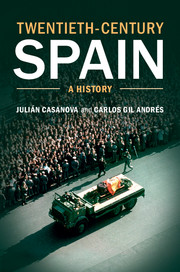Book contents
- Frontmatter
- Contents
- List of illustrations
- Key figures
- List of abbreviations
- Twentieth-century Spain timeline
- Maps
- Introduction
- Part I The monarchy of Alfonso XIII
- Part II The Second Republic
- 5 A parliamentary and constitutional republic
- 6 A republic beleaguered
- 7 1936: the destruction of democracy
- Part III The Civil War
- Part IV Franco’s dictatorship
- Part V Transition and democracy
- Guide to further reading
- Index of names and authors
- References
6 - A republic beleaguered
Published online by Cambridge University Press: 05 July 2014
- Frontmatter
- Contents
- List of illustrations
- Key figures
- List of abbreviations
- Twentieth-century Spain timeline
- Maps
- Introduction
- Part I The monarchy of Alfonso XIII
- Part II The Second Republic
- 5 A parliamentary and constitutional republic
- 6 A republic beleaguered
- 7 1936: the destruction of democracy
- Part III The Civil War
- Part IV Franco’s dictatorship
- Part V Transition and democracy
- Guide to further reading
- Index of names and authors
- References
Summary
After the CEDA’s and Partido Radical’s victory in the November 1933 elections, Niceto Alcalá Zamora asked Alejandro Lerroux to form a ‘purely republican’ government of the centre, which would not include leftist republicans or the CEDA, which had failed to declare publicly its adherence to the Republic. The veteran leader of the Partido Radical thought that a parliamentary alliance with the CEDA would ensure a majority, and therefore governability, and would enable this ‘accidentalist’ right to be incorporated into the Republic, isolating the monarchist extreme right. However, the CEDA’s strategy included forming a government, presiding over it and revising the Constitution.
The CEDA threatened violence unless they were allowed to govern, and the socialists proclaimed their intention of unleashing a revolution if the CEDA entered the government. After the revolution of October 1934, the potential centrist solutions proposed by Lerroux and his supporters were blocked by the CEDA’s strategy of winning power. The employers went into action and recovered the ground they had lost with the arrival of the Republic. Agrarian reform became a thing of the past and Gil Robles, minister of war from May to December 1935 reinforced, with his appointments policy, the power of the anti-Azaña officers and introduced a rightist element into the army.
- Type
- Chapter
- Information
- Twentieth-Century SpainA History, pp. 127 - 146Publisher: Cambridge University PressPrint publication year: 2014

